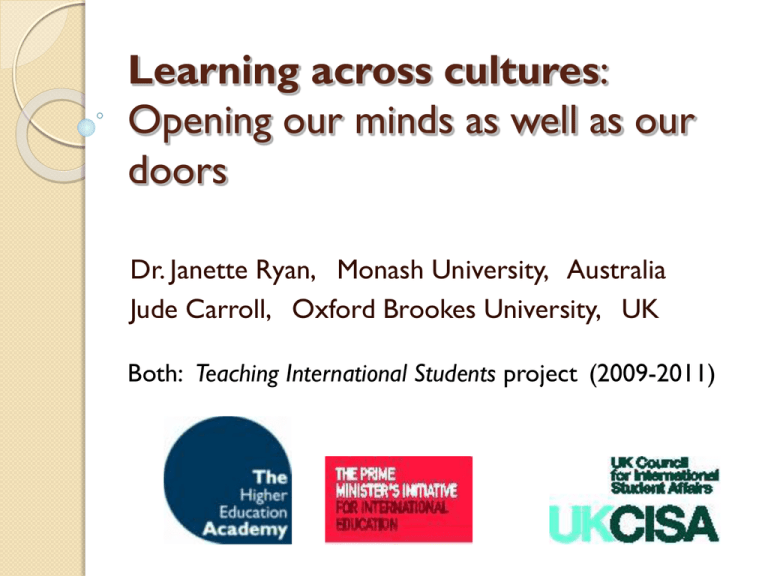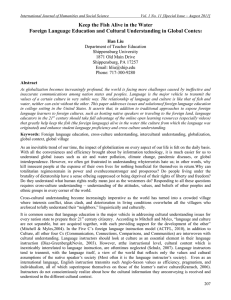ISSOTL slides - Oxford Brookes University
advertisement

Learning across cultures: Opening our minds as well as our doors Dr. Janette Ryan, Monash University, Australia Jude Carroll, Oxford Brookes University, UK Both: Teaching International Students project (2009-2011) Ideas there are differences in academic cultures and in learning approaches identified by comparison and contrast. One example: Confucian and Western education learning from flows of people and ideas across cultural academic traditions? ….. a new approach, ‘transcultural’ Use examples from critical thinking and academic writing / plagiarism to illustrate transcultural teaching and learning An aside: The temptation to reflect upon this presentation as a clear example of one way in which information can be analysed, critiqued and conveyed ….. Did you noticed the structure and tone already? … or was it so common as to be invisible? Choosing the ‘lens’ Difference, contrast, surprise Language and culture? Language or culture? Dangers of complexity ‘What assumptions am I making that are wrong?’ Academic cultures vary “ Culture” …. systems of human practice Ways of knowing and being, ontology, epistemology, methodologies and intellectual practices ideas about writing, analysis, evaluation ‘Performativity’ [how you act out these ideas] We all have one …. or several Reversing the lens…. …. the same critical eye on our own assumptions and beliefs? Become self-aware? One prompt is experiencing differences …. Academic cultures: Same words ….. different meanings, different practices Not simply differences Imbued with judgments on quality Usually seen as binary …. quickly leads to opposition ‘Western’ ‘Confucian’ Critical thinking Follow the Master Independent learning Dependence on the teacher Student-centred learning Respect for the teacher Adversarial stance Harmony Argumentative learners Passive learners Achievement of the individual Achievement of the group Constructing new knowledge Respect for historical texts ‘Deep’ learners seeking meaning ‘Surface’ or rote learners Partial and biased Much of the evidence produced for the way Chinese students behave in classroom settings has been drawn from reports and perceptions by Western instructors, thus filtered through their own values, expectations and standards’ Clark and Grieves, 2006 p. 60 As much variation within as between Binary and hierarchical ‘West is Best’ ‘Western European’ [wide actual geography … US, NZ, etc ] Anglophone [or at least in the sources I read] ‘Winners’ described through idealised characteristics. The ideal treated as real. Flow between academic culture / contexts … what happens on arrival? ….. ‘an international student’ [‘international staff’?] Attract a large literature Trigger much discussion Learning and teaching responses Phase One ( 1990 …. ) ‘fix the student’ Phase Two: (2001 ...) ‘fix the teacher’ Phase Three: ( ? now ) ‘fix the institution’ 1. Students’ must change (1990 +) remediation, ‘gaps’ students as deficits. Students as expressions of deficit systems. ….common discourse for all students. But for international students, the assumption seems to be that they come with nothing of worth. They can finally start learning….. once they have their gaps filled. 2. Teachers ‘accommodate’ and ‘adapt’ (c. 2001 +) ‘Making allowances’ Making learning practices more explicit ‘Rules of the game’ . Assisting international students to become skilful ‘players’ Reviewing classroom practices for inclusion, trying to remove exclusion (2009-11) ‘Teaching International Students’ project TIS activities Website with teaching Resources Bank http://www.heacademy.ac.uk/internationalisation Research database Outreach activities and partnerships Series of events (27 this year) 3. ‘Internationalise’ the institution Beyond assertion? ‘largely located in the policy domain and generally ignoring the cultural dynamics of teaching and learning’ (Huisman, 2010) Studies of the impact are ‘small scale, scattered and a-theoretical’ An undertaking of prodigious intellectual and practical endeavour. McTaggart, 2003 ….a transformation of prodigious intellectual, practical and emotional endeavour Carroll, 2010 A new way? ‘third space’ or ‘bridge’ metaphors traffic is not all one way ….. not all towards ‘the winners’. Not all from teacher to student. Working with students as a source of mutual adaptation ‘Not just legitimisation of Western knowledge’ Requirements for ‘third space’? Genuine dialogue. Recognising and valuing others academic and cultural practices. ‘Bearers of culture, not bearers of problems’ Generalise with care…… Self-awareness. Moving from invisible to conscious. Based in reality, not the ideal. “Rules of the game”. Making the context explicit ‘Owning’ your own point of view Challenging assumptions and stereotypes ‘Chinese Learner’ Largest group Stereotypes inaccurate, out of date, unhelpful ‘Gap’ is narrowing Rapid changes in China Stereotypes of Chinese/‘CHC’ students Western views of CHC students filtered through eyes of teachers observing international students, struggling in culturally and linguistically different learning environments ‘Western’ and ‘Asian’ or CHC scholarship and learning described in binary terms: ‘deep/surface’, ‘adversarial/harmonious’, ‘independent/dependent’ Construct Asian or CHC students in ‘deficit’ terms [ the antithesis of Western academic virtues ] ‘Chinese-ness’ ‘…in effect, deviance within Western norms, and generally being interestingly different within mainstream, that is Western, psychology’ (Watkins and Biggs, 2001) Summing up most commentators on the differences [note: I am not linking the view to W and B] Essentialising goes both ways Here is Gu, a very influential Chinese educator, looking across academic cultures: American teachers seldom place very high demands on students ….. American students do not have a sound foundation in reading, writing and arithmetic’ (Gu, 2001) the ‘paradox’ of the Chinese Learner Watkins and Biggs, 2001. ‘surface approach’ but ‘deep learning’ “surplus” theory. cooperative, diligent, hard working, ‘invariably have a high regard for education’ (Lee, 1996) Murphy (2005) ‘the model minority’ Primary importance of social context It is aspects of the social context, rather than cultural heritage per se that affects student learning ….. we need to consider teaching and learning, not just Chineseness of students or teachers’ Rao and Chan, 2009 in a huge review of CHC learning cultures Changing contexts Rapid and profound physical, social and cultural transformations in China Much diversity within China eg. developed coastal vs less-developed inland regions (Hu, 2003), Chinese learners little different from Western counterparts (Shi, 2006) Education reform in China over past 5-10 years – move to student-centred learning and autonomous learners Beijing No. 4 Primary School Life science curriculum in Shanghai middle schools DNA extraction & observation The ‘Chinese learner’ Will be very diverse, BUT… Will be an only child (3 ‘onlys’; 6 adults per child) High parental expectations and extrinsic control Competitive nature of Chinese education. Largely exam based (changing up to High School) Hard working (ability vs effort) A lot at stake (consequences of failure) Chinese students’ expectations More pastoral care from teachers – relationship with teachers is paramount Home students should initiate contact More structure, less prepared for more independent study (but can think ‘critically’) Silent in class but want to ask questions after class Talking inhibits understanding → Will need to clearly establish and model your expectations (eg you are open to criticism) Clear differences in prior experiences [from UK students] Example: writing amount of writing ways in which text is constructed ways in which text is organised ways of catering to readers’ needs perceptions of readers’ needs ways of incorporating knowledge of others Difference is not deficit It is particularly infuriating to hear problems with rhetorical styles attributed to imagined inadequacies in the student’s education in their home country. I have often had conversations in which it has been suggested that Oriental students come from backgrounds in which originality and critical thinking are valued less than acceptance of orthodoxy. Apart from the lack of critical thinking apparent in the use of the category Oriental, such analysis is misleading because it confuses differences in style of expression with a lack of academic rigour. What it fails to understand is that a prizewinning English academic essay translated word for word into Japanese is likely to be received as clumsy and ill thought out. (Yoshino, 2004, p. 10) Keep looking ….. Turn the lens “Chinese students can’t criticise” or Am I clear about what I mean? How else might it show? Am I expecting it too soon? [‘A half empty bottle makes the most noise’] Am I expecting it in a certain format? Is the copying and restating a personal expression of the student’s thought? Operationalising transcultural teaching 1. Local teachers are self-aware. They avoid essentialising and check their own assumptions. They make the context clear. They make the boundaries explicit…. [Move from ‘be critical’ to ‘this is how we recognise and define criticality here…. not because it IS criticality but because it is how we do it……] Transcultural teaching 1. 2. Self-aware and meta-aware Negotiate and communicate what is negotiable. Teach the ‘rules of the game’. Try and understand different ways. Look for possibilities of new understandings, new knowledge. Transcultural teaching 1. 2. 3. Self-aware Negotiate the negotiable. Flexible and variable demonstrations of learning. 1 in 5 [1 in 4] will return to very different contexts. All will apply learning in a diverse global world. How I have been trying to do this with plagiarism 1. Self-awareness Moving beyond the fetishising of citation. Many meanings of a copied text – not just the marker of cheating or the sign of substandard learning. Not acceptable, but not a moral issue……. Not equating a particular way of ‘showing your own work’ with learning 2. Negotiating and sticking Teach what is non-negotiable Uphold values and insist on improvement use other people’s ideas use other people’s work give credit when your work draws upon others’ work authority credibility 3. Be open to ways of demonstrating non-negotiable skills and knowledge Authentic, transferable, useful If simulating peer-reviewed journal articles is needed, then teach it. Don’t confuse a single discourse style with ‘academic writing’ Why might this be worth doing? Definitely tough to operate this way. Definitely triggers very strong responses The burden of not knowing My culture, my background, everything is different from them, so I have, not risk, but I have too many things, too many MORE things, that I have to think about than other students. I think I lost so much confidence of mine. I’m thinking I have so many. I’m talented, I want to think like that, but whenever I go to tutorials, I feel like I can’t do anything, so I’m not respected. (Viete and Peeler 2007, 181 ‘Good teaching and learning are the common treasures of humanity’ Dr Kang Changyun, Beijing Normal University







